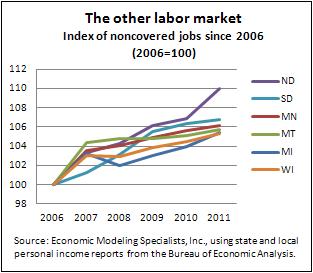You have to look long and hard to find positive employment news these days. But there appears to be some good news lurking outside the spotlight of the traditional job market you typically hear about in regular government reports.
Much of the state and national information on employment comes from the Quarterly Census of Wage and Employment (QCEW), a state-administered survey whose information is then passed up the ladder to the federal Bureau of Labor Statistics. The QCEW counts employment in sort of a round-about fashion: Companies with at least one paid employee must register with their home state’s unemployment insurance (UI) system and then regularly report their company’s employment levels, and these reports are the basis of the QCEW.
While the large majority of workers are covered by the UI umbrella, there is nonetheless a hole in the employment doughnut because workers in some occupations or industries are exempt from UI. There are no official government counts of this so-called noncovered worker population, and it’s a hard group to measure.
For starters, states have different exemptions to UI. There are more than 30 UI exemptions in Minnesota alone, for example, including (among others) self-employed workers, some farms, insurance and real estate salespeople who work on commission, most religious personnel and all elected public officials. Some of these categories, like the self-employed, are particularly difficult to measure (and is the focus of the cover article in the January fedgazette.)
Private firms have begun to reverse-calculate these figures through a complicated process that uses employment and income data from the likes of the Bureau of Economic Analysis, which goes to great lengths to identify income-producing jobs. Estimates are then developed for jobs not typically covered by UI.
Economic Modeling Specialists, Inc., for example, is an economics and labor market consulting firm in Moscow, Idaho. It shared its estimates on noncovered workers with the fedgazette, as well as its methodology, “quite a bit (of which) is based on the BEA's much-appreciated work in this area,” said Jared Miller, an EMSI data analyst.
Unlike the population of covered workers, which has taken a big and well-publicized drop during the recession, EMSI’s data show steady, if modest, growth among noncovered workers in every district state, as well as the nation as a whole (see chart).

There are also a couple of important caveats to acknowledge that might well take some of the shine off this seemingly good news. For starters, the noncovered population is a count of jobs, not employed individuals, which means there are multiple plausible interpretations for job trends. From an optimistic standpoint, a growing number of noncovered jobs might mean there are more employed individuals in this gray area of employment. However, a growing number of noncovered jobs might also be indicative of growing part-time jobs and outsourced labor in the form of independent labor contracts. Were this the case, total noncovered workers could well be stagnant or even falling as they take on more of these jobs to make ends meet.
Secondly, noncovered job counts cannot distinguish employment duration; in many cases, someone self-employed for a single month would count the same as a year-long job, whereas QCEW is more precise, reporting monthly job counts as well as quarterly and annual averages.
Ron Wirtz is a Minneapolis Fed regional outreach director. Ron tracks current business conditions, with a focus on employment and wages, construction, real estate, consumer spending, and tourism. In this role, he networks with businesses in the Bank’s six-state region and gives frequent speeches on economic conditions. Follow him on Twitter @RonWirtz.





